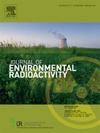NRU反应堆关闭后白垩河遗址近地表环境氚浓度变化趋势
IF 2.1
3区 环境科学与生态学
Q3 ENVIRONMENTAL SCIENCES
引用次数: 0
摘要
本文研究了加拿大核实验室(CNL)乔克河站点国家通用研究(NRU)核反应堆关闭后的恢复阶段。2009年,在反应堆容器维修期间,NRU关闭了一年多的时间,然后在2018年永久关闭。在这两种情况下,在大气、降水、植被和土壤中都取样了氚。组织游离水氚(TFWT)和有机结合氚(OBT)分别在离地1 m和2 m的植物和树叶中采集。两个连接干燥的上坡地点和邻近的下坡沼泽的样带进行了采样。这些研究样带位于远离反应堆场地和废物管理区的地方,因此,由于大气水蒸气和近地表地下水的区域地球物理隔室中当地氚的稀释(在传入降水的帮助下),预计将代表纯回收。评估了NRU反应堆关闭后CNL环境氚的变化趋势,并推导了近地表地层(大气、生物圈/植物和根际/地下水)氚的环境半衰期。看来,在4年的时间里,历史氚的纯本地(纯恢复阶段)稀释已经达到了现在明显受到来自CNL废物管理区的东南风的远程大气氚羽流影响的水平。排除与东南风和远距氚羽流相关的事件,使采样的近地表地球物理地层的趋势更加一致。趋势线指数提供T1/2 = 1.30±0.24年氚的环境半衰期。小气候的作用可能需要进一步研究,但在TFWT中观察到的干湿地点之间的微小差异已经表明,氚的环境半衰期适用于其他地点的恢复。CNL特定地点恢复过程的特征包括OBT和地下水HTO趋势(半衰期指数)对排除远程氚羽流下收集的样品不敏感,而大气HTO趋势(指数),特别是降水HTO趋势(指数)分别受到高达49%和267%的影响。TFWT(环境半衰期指数)趋势的敏感性不太明显,因为在排除远程羽流事件后,该指数仅下降了35%。综上所述,在NRU反应堆关闭后的4年里,氚转移的驱动因素(大气HTO和降水HTO)已经受到CNL远程源氚羽流的实质性影响,但环境氚的接收室要么没有受到远程氚羽流的影响,要么只有轻微的影响。这意味着在CNL大气中完成回收阶段(并在降水中将氚冲洗出来),但在准静止阶段尚未开始的OBT和地下水HTO的接收舱中尚未完成回收。本文章由计算机程序翻译,如有差异,请以英文原文为准。
Trends in near-surface environmental tritium concentrations at chalk river site following shut down of the NRU reactor
Recovery phase following the shutdown of the National Research Universal (NRU) nuclear reactor at Canadian Nuclear Laboratories' (CNL's) Chalk River site is studied here. In 2009, NRU was shut down for a period longer than a year during reactor vessel repair and then was shut down permanently in 2018. In both cases, tritium was sampled in the atmosphere, precipitation, vegetation, and soil. Tissue free water tritium (TFWT) and organically bound tritium (OBT) were collected in plants and in tree leaves at 1 m and 2 m above the ground. Two transects connecting dry uphill locations and neighbouring swamps downhill were sampled. These study transects are located away from the reactor site and waste management areas, and as such, are expected to represent pure recovery due to dilution of local tritium in the regional geophysical compartments of atmospheric water vapour and near-surface groundwater (aided by incoming precipitation). Trends in environmental tritium at CNL following the NRU reactor shutdown were assessed and the environmental half-life of tritium was derived for near-surface strata (atmosphere, biosphere/plants, and rhizosphere/groundwater). It appears that in 4 years, pure local (pure recovery-phase) dilution of historical tritium has reached the level at which it is now tangibly affected by remote atmospheric tritium plumes coming from CNL waste management areas with southeast (SE) winds. Exclusion of episodes associated with SE wind and with remote tritium plume results in more coherent trends across sampled near-surface geophysical strata. Trend-line exponents provide T1/2 = 1.30 ± 0.24 years of environmental half-life of tritium. The role of microclimate may require further investigation, but insignificant differences between wet and dry locations observed in TFWT already imply applicability of the environmental half-life of tritium to other sites in recovery.
Features of the site-specific recovery process at CNL include insensitivity of OBT and groundwater HTO trends (half-life exponents) to exclusion of samples collected under the remote tritium plume, whereas atmospheric HTO and especially precipitation HTO trends (exponents) appear affected by as much as 49 % and 267 %, respectively. The sensitivity of trend for TFWT (environmental half-life exponent) was less tangible, because of only moderate 35 % decrease in exponent after exclusion of remote plume episodes. In summary, in 4 years after the NRU reactor shutdown, the drivers of tritium transfer (atmospheric HTO and precipitation HTO) are already under substantial influence of the tritium plume from remote sources at CNL, but recipient compartments of environmental tritium are either not, or are only slightly affected by the remote tritium plume. This implies recovery phase completion in the CNL atmosphere (and in precipitation washing tritium out of it), but yet unfinished recovery of recipient compartments of OBT and groundwater HTO where quasi-stationary phase has not yet started.
求助全文
通过发布文献求助,成功后即可免费获取论文全文。
去求助
来源期刊

Journal of environmental radioactivity
环境科学-环境科学
CiteScore
4.70
自引率
13.00%
发文量
209
审稿时长
73 days
期刊介绍:
The Journal of Environmental Radioactivity provides a coherent international forum for publication of original research or review papers on any aspect of the occurrence of radioactivity in natural systems.
Relevant subject areas range from applications of environmental radionuclides as mechanistic or timescale tracers of natural processes to assessments of the radioecological or radiological effects of ambient radioactivity. Papers deal with naturally occurring nuclides or with those created and released by man through nuclear weapons manufacture and testing, energy production, fuel-cycle technology, etc. Reports on radioactivity in the oceans, sediments, rivers, lakes, groundwaters, soils, atmosphere and all divisions of the biosphere are welcomed, but these should not simply be of a monitoring nature unless the data are particularly innovative.
 求助内容:
求助内容: 应助结果提醒方式:
应助结果提醒方式:


